Follow the Leaders
Keys to Improving Employee Relationships and Productivity
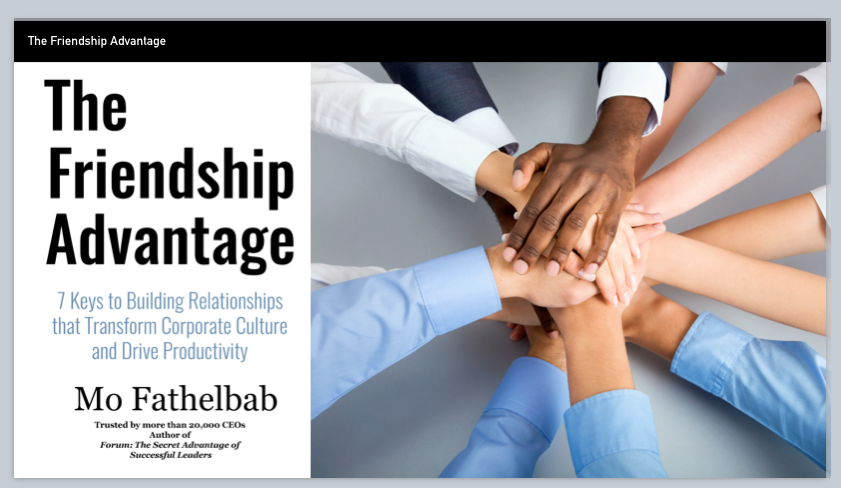
Lifelong friendships are often developed within a confidential peer roundtable setting, and it’s no wonder why. When certain principles of trust and candor are followed, and experiences are shared as part of a “no advice” protocol, nothing is off limits. It’s not uncommon to hear, “I’m closer to this group than I am my best friends.”

“So, initially, that really warmed my heart,” he told the VACEOs Quarterly Luncheon audience on January 24. “But then it started bothering me, because the reason we have these roundtables is not so that we would have better relationships than we have in the rest of your life. It’s so that the roundtables can help you be a better person in the rest of your life.”
Fathelbab is often called in to train and coach VACEOs Roundtable members on how to get the most out of their roundtable experience. In fact, his book Forum: The Secret Advantage of Successful Leaders is required reading for all new members.
“Having friends at work has profound impact on productivity, happiness and company culture,” says Fathelbab. At the luncheon event, Mo introduced his new book, The Friendship Advantage: 7 Keys to Building Relationships that Transform Corporate Culture and Drive Productivity. The content features guiding principles to help you be a better person and leader, and viable ways to help you strengthen employee bonds in your organization.
SUSPEND JUDGEMENT, HAVE SOME FUN, BE VULNERABLE …

For business owners, The Friendship Advantage promises to help them strengthen the bonds that improve employee productivity, happiness and well-being, as well as boost bottom lines through higher retention rates and a richer company culture.
But it’s not easy work being vulnerable and free of judgment, as we learned during Mo’s highly interactive presentation. After one exercise, attendees declared it felt “cathartic” and “fulfilling” to open themselves up so completely to an unknown person at their table. They felt “human” and “real.”
Now, imagine the possibilities.
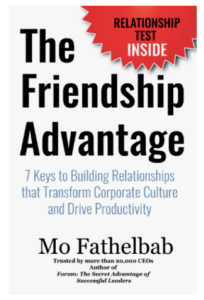
- Judgment Free
- Mischievous Fun
- Vulnerability
- Reliability
- Shared Purpose and Values
- Sharing and Generosity
- Kind Truth
*Source: Mo Fathelbab Presentation, “The Friendship Advantage;” January 24, 2019; VACEOs Quarterly Luncheon.
Related articles:
- 7 Benefits of Joining a CEO Peer-to-Peer Roundtable
- VACEOs CEO Roundtable Experience: 5 Frequently Asked Questions
- Guided by the Gestalt Protocol, Peer Groups Offer VACEOs Members a Safe Haven
Your Business Just Got a Negative Review. Now What?
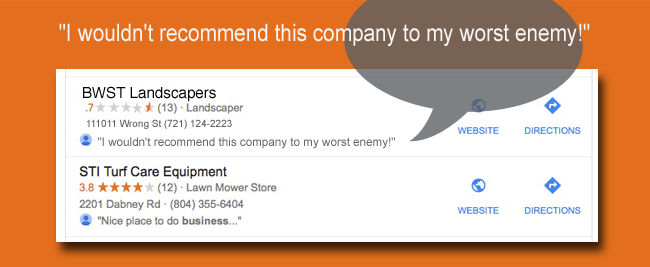
We live in an age where it’s possible for companies to thrive or die based on customer reviews. “Reviews are important for almost any small to mid-sized business,” says Chris Leone, president of WebStrategies, Inc. “These days, it’s hard to be a new customer and not see an online review at some point in your buying journey.”

And like it or not, your buyers’ journeys often begin on Google. According to Leone, prospects who search for a type of service in the search engine (e.g., “staffing company VA”) are more likely to choose companies that have strong reviews associated with them.
If a customer doesn’t know your web address and chooses to search using your business name (e.g., “ACME Supply”), they’ll quickly discover reviews of your business along with your website. A search result page littered with low-star reviews doesn’t make a great first impression. Another not-so-great look? Poor ratings on Glassdoor – a well-known site where employees can rate their employers.
To sum: Less-than-stellar reviews can impact your brand image, your bottom line and the likelihood that a star employee will come calling.
ONLINE REVIEWS: A CONCERN FOR B2C AND B2B BUSINESSES ALIKE
Think only B2C business owners should be concerned with customer reviews? Think again. There are myriad review websites that closely examine the services and products B2B companies provide, too – from Amazon Customer Reviews to Which? to TrustPilot. If you own a business, it’s also important to monitor your online presence on sites like FinancesOnline, G2Crowd and bbb.org (Better Business Bureau).
If you’re a small to mid-size business owner with limited resources and time, where do you begin? Leone stresses that any website visible to your prospects should be on your radar. “You can find these by doing a Google search and scanning the search results page,” he explains. “Google will show different review sites for different industries, depending on what’s out there and the intent or mindset of the person doing the search. In short, act like a prospect would and take note of what you see. Then work to improve it.”

YOU GOT A NEGATIVE REVIEW. NOW WHAT?
Halloran is diligent about asking for customer feedback; in fact, he uses a local service to contact customers who’ve used his service in the last 30 days. It’s a great source for garnering positive reviews. His (thankfully) limited experience with negative reviews has taught him that folks are often quick to pull the social media trigger rather than contact a business owner directly with a concern or complaint.
Essential Steps for Handling Negative Reviews*
- Be professional and avoid getting personal
- Thank your reviewers and customize your responses
- Take the time to upload an image with your response
- Indicate you’ve taken the necessary action
*Source: Small Business Association: https://www.sba.gov/blogs/how-handle-negative-reviews
“Typically, what we find is that [a negative review] stems from not necessarily the contact you’ve been doing business with directly, but someone else in the organization that just has a beef, and rather than reaching out to us as an entity, they just go straight to social media,” says Halloran.
Halloran’s approach to reacting to less-positive reviews is based on a key core value of his business: transparency. A typical response includes an immediate acknowledgment of the concern and a thank-you for the feedback; for example, “We’ve researched the situation and found the following… Thank you for bringing this to our attention.”
Most importantly: Be diligent and vigilant, and respond quickly should an issue arise.
Leone agrees that it’s important to respond. “Do so empathetically. Your response is a great opportunity to show your human side and that you’re trying to get better. No business is perfect, and people get that. That being said, if there are recurring trends in the negative reviews people leave, you should worry less about the reviews and more about fixing the systemic problem within your business that’s causing the bad reviews.”
Symbols and Artifacts by Scot McRoberts

“One of the few things I brought home with me was his college ring. Class of 1958, University of Texas, with a huge longhorn on the side and his fraternity letters on the stone.”
Earlier this month, I travelled to Texas to help my sister sort through my dad’s stuff. He passed away in April, having lived a long and fruitful life. As we sorted through pictures and letters, I envisioned the arc of his long and interesting life. I marveled at how much of him was in me.
One of the powerful influences he (and mom) had on me was a love of learning. Doing well in school and going to college was never a stated expectation. It just was. Mom and Dad supported me and my siblings through college, paying the way and cheering us on.
Back to Dad’s stuff. One of the few things I brought home with me was his college ring. Class of 1958, University of Texas, with a huge longhorn on the side and his fraternity letters on the stone. I really cannot remember him not having it on his right hand. I do remember the stories of his college days that I associate with that ring.

What are the things in our businesses and lives that speak to our employees, customers and community? What do these things say to people?
For years, we have given engraved baseball bats to speakers and key volunteers to recognize their contributions. I see them in photos from events, and in the offices of the recipients. I hope they communicate appreciation, that the person “hit a home run” for us, and that we regard them as a heavy hitter.
You probably have symbols and artifacts in your business. These objects can be a powerful part of your culture and how you communicate it. A reminder to stay the course, if you will.
I’ve chosen to wear my father’s class ring now. In a way, the large, heavy piece of jewelry with the chipped stone conjures up the spirit of the man who shaped me. I’m a better leader because of him.
Take a minute to think about the objects in your business and your life that offer direction and meaning. I bet you will come up with some good ones. Please share them in the comments!
Gary Chapman Brings Languages of Appreciation to Richmond
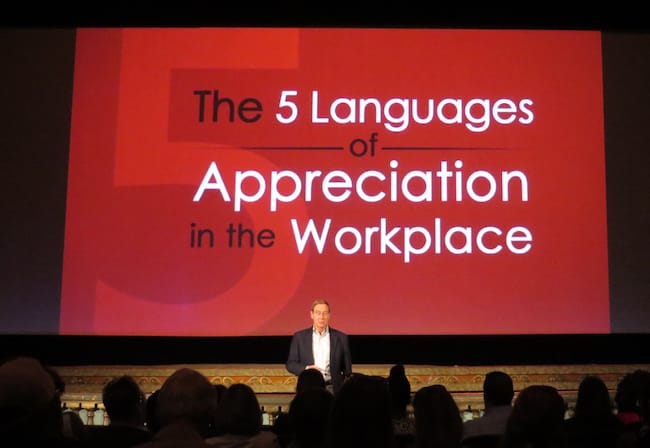
Dr. Gary Chapman is a number-one New York Times best-selling author known throughout the world for his book The 5 Love Languages: The Secret to Love that Lasts. The book, believed to be one of the most widely read in the world, has sold now 12 million copies in English, and has been translated into 40 other languages.
Using in-depth research provided by Dr. Paul White, a psychologist who specializes in helping family-owned businesses, Chapman has adapted the Love Languages principles taught in his original book for the business world in The 5 Languages of Appreciation in the Workplace. Chapman and White’s teachings have benefited employees and individuals across a variety of organizations, including Microsoft, Nationwide Insurance, NASA and many others.
On August 14, in front of a large crowd at the Byrd Theatre in Richmond, Virginia, Chapman treated the audience – which included a select group of VACEOs members – to a behind-the-scenes look at the research and principles behind the book.
APPRECIATION MATTERS. AND IT CAN AFFECT YOUR BOTTOM LINE.
It’s a startling fact: “70 percent of the people who have jobs in this country say they feel little to no appreciation coming from the people with whom and for whom they work,” says Chapman. “Sixty-four percent of the people who leave one job and move to another job say they moved primarily because they didn’t feel appreciated for their work.”
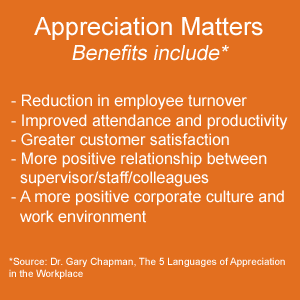 In fact, Chapman and White say the need to feel appreciated at work is the same fundamental need as the need to feel loved in family relationships. Under appreciated employees can create a crippling ripple effect across your business. Team members become disconnected from the organization’s mission, and, soon, complaints to colleagues and drama follow. Your customers notice the lack of dedication to their needs.
In fact, Chapman and White say the need to feel appreciated at work is the same fundamental need as the need to feel loved in family relationships. Under appreciated employees can create a crippling ripple effect across your business. Team members become disconnected from the organization’s mission, and, soon, complaints to colleagues and drama follow. Your customers notice the lack of dedication to their needs.
On the other hand, when employees feel appreciated, employee turnover is decreased, sick days are minimized, and employees are energized and give more. Your business emits a positive energy, and customers want to do business with you. Customer satisfaction goes up, and you benefit from a more positive relationship with your staff.
But just telling your employees you appreciate them isn’t the answer. “Just as a husband who’s telling his wife that he loves her, and that’s not her Love Language, you tell your employees you appreciate them verbally, you’re getting about 40 percent of your people,” explains Chapman. “The other 60 percent aren’t getting it, because that’s not their Appreciation Language. That’s not what makes them feel appreciated. Words just roll off on them. In order for it to be effective, [your appreciation] has to be individualized.”
APPRECIATION VS. RECOGNITION
Before we speak the language, it’s important to understand the difference between recognition and appreciation.
“Recognition is largely about behavior,” Chapman writes in his book. “Appreciation, conversely, focuses on performance plus the employee’s value as a person. Recognition is about improving performance and focuses on what is good for the company. Appreciation emphasizes what is good for the company and what is good for the person.”
THE 5 LANGUAGES OF APPRECIATION IN THE WORKPLACE (GARY CHAPMAN)
According to Chapman, each of us has a primary and a secondary Appreciation Language, and each language can have a dialect.
The Five Languages include:
- Words of Affirmation
- Quality Time
- Acts of Service
- Tangible Gifts
- Physical Touch
Chapman cautions the audience not to be alarmed by number five: His background in anthropology tells him there are no human cultures in which people do not touch. He addresses the appropriateness of physical touch in the workplace thoroughly in his book, which we encourage you to read since it also covers specific dialects that are part of each language, and the specific skills and guidelines you need to develop as a leader to effectively express appreciation.
WHAT LANGUAGE ARE THEY SPEAKING?
How can you tell which Appreciation Language your employees and co-workers prefer? According to Chapman, there are three informal ways to find out.
1. Observe their behavior. “Just observe how they respond to other people,” says Chapman. “If they’re always offering to help other people on projects or frequently ask, ‘Is there anything I can do for you,’ you see what they’re doing is Acts of Service.”
2. Observe their requests of others. “If they’re always initiating invitations to lunch with colleagues, you can assume that Quality Time is their language, because they’re asking, ‘Would you like to go to lunch with me?’ So what are their requests? If they’re the person who’s always saying, ‘Would you help me with this,’ they’re asking you for Acts of Service.”
3. Observe what they complain about. “The complaint really reveals a person’s Appreciation Language,” says Chapman. “If they’re saying ‘I can’t ever please him,’ ‘I can never please him,’ ‘I can’t ever please her,’ they’re telling you that Words of Affirmation is their language.”

Todd Mawyer and Dr. Gary Chapman
Ready to empower your organization by encouraging people? Why not purchase copies of 5 Languages of Appreciation in the Workplace for your employees like Todd Mawyer, CEO of TK Promotions, Inc., did?
His plan is to encourage his team to take the language evaluation test that’s included in the book and then discuss what they’ve learned together.
Protecting Your Investment: Essential HR Practices for Your Business

As a small business owner, you are keenly aware that even if you worked 24/7 there still would not be enough time to get everything done. Being an effective manager requires knowing the critical elements and guidelines to lead your team. Having a HR program and guidebook in place is especially critical. Even though your program will be dependent on multiple factors — such as company size, industry, regulatory and compliance bodies, here are some basics to include in your program.
HR guidelines to get started:
- Creation and maintenance of three specific employee files
- Publication of an employee guidebook with specific policies
- Posting of required state and federal notices
Employee File Guideline
Your employee file should include at least these three files:
- Employee Payroll File. This file should include: Direct Deposit Form, W-4, VA-4 and other withholding forms, and the offer letter. The file may be shared with the payroll or finance department.(Note: The file may be kept with the finance department.)
- Employee HR File. This confidential file will have general employment information on the employee and include his/her: Resume, Employment Application, Offer Letter, Contract or Agreement, Performance Evaluation, Awards, Disciplinary Documents and finally termination or exit interview information.
- Employee Medical/Benefit File. A separate, confidential medical/benefit file for health and medical issues on each of your employees should include: Applications for insurance, notes from a doctor excusing a person from work, medical examination results, information related to a disability, beneficiary forms, open enrollment forms and any other benefit related documents.
Employee Guidebook Guidelines
A good employee guidebook should contain several key sections and information on your company culture, policies, and procedures. Here are the must-haves:
- An introductory statement to explain the purpose of the handbook and at will employment.
- The guidebook should list the following company policies:
|
|
|
|
|
|
|
|
|
|
|
|
|
|
|
|
|
- Below are some remaining key topics that may be included based on your business and industry:
a) Timekeeping and Payroll: Timekeeping Procedures, Paydays, Pay deductions, Time Off
b) Work Conditions: Violence in the Workplace, Workplace Safety, Drug Free Workplace Policy, Employee Standard of Conduct and Disciplinary Policy, Office and Facility Information
c) Benefits: Sick Leave, Personal Leave, Vacation, Holidays, Bereavement Leave, Jury Duty Leave, Military Leave, Maternity/Paternity Leave, Group Insurance, Worker’s Compensation Insurance, Healthcare Continuation, 401K, Business Expense Reimbursement
Posting of Required Notices
Lastly, I suggest you purchase a combined state and federal poster that keeps you in compliance with posting regulations. If you have more than one office, you will need to post this in each location. While there are many sources, this recommended version costs less than $20.00. Visit VA – Federal Posters.
Want to take it to the next level? Join me and Janet Duncan for the VACEOs Square Table event: “How Best to Manage Disruptive Behavior in Your Workplace” on September 6. Learn more about this Square Table event.

Beth Williams is the Director of Human Resources at Warren Whitney. She has worked in human resource management for more than 25 years with experience that spans many diverse industries, including accounting, energy, financial services and banking, legal services, pharmaceuticals, IT, and non-profit. Learn more. Warren Whitney is a valued Sponsor of Virginia Council of CEOs.
Recent Comments